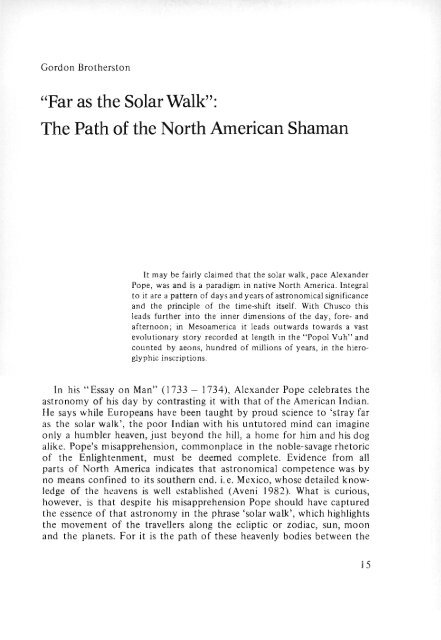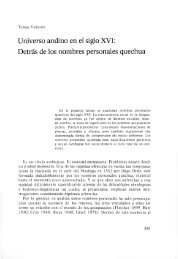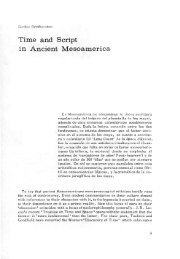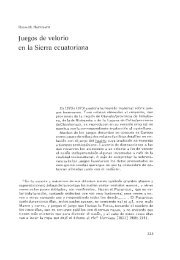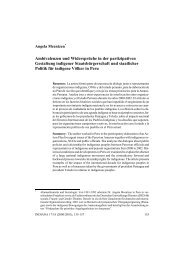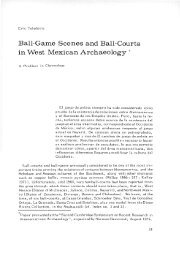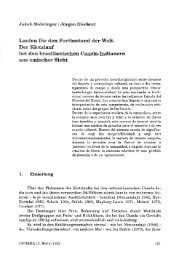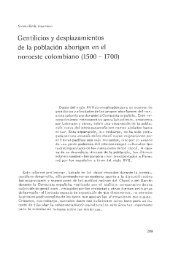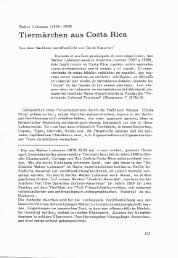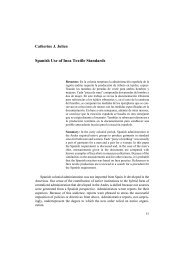o - Ibero-Amerikanisches Institut
o - Ibero-Amerikanisches Institut
o - Ibero-Amerikanisches Institut
Create successful ePaper yourself
Turn your PDF publications into a flip-book with our unique Google optimized e-Paper software.
Gordon Brotherston<br />
"Far as the Solar Walk":<br />
The Path of the North American Shaman<br />
It may be fairly claimed that the solar walk, pace Alexander<br />
Pope, was and is a paradigm in native North America. Integral<br />
to it are a pattern of days and years of astronomical significance<br />
and the principle of the time-shift itself. With Chusco this<br />
leads further into the inner dimensions of the day, fore- and<br />
afternoon; in Mesoamerica it leads outwards towards a vast<br />
evolutionary story recorded at length in the "Popol Vuh" and<br />
counted by aeons, hundred of millions of years, in the hieroglyphic<br />
inscriptions.<br />
In his "Essay on Man" (1733 - 1734), Alexander Pope celebrates the<br />
astronomy of his day by contrasting it with that of the American Indian.<br />
He says while Europeans have been taught by proud science to 'stray far<br />
as the solar walk', the poor Indian with his untutored mind can imagine<br />
only a humbler heaven, just beyond the hill, a home for him and his dog<br />
alike. Pope's misapprehension, commonplace in the noble-savage rhetoric<br />
of the Enlightenment, must be deemed complete. Evidence from all<br />
parts of North America indicates that astronomical competence was by<br />
no means confined to its southern end. i.e. Mexico, whose detailed knowledge<br />
of the heavens is well established (Aveni 1982). What is curious,<br />
however, is that despite his misapprehension Pope should have captured<br />
the essence of that astronomy in the phrase 'solar walk', which highlights<br />
the movement of the travellers along the ecliptic or zodiac, sun, moon<br />
and the planets. For it is the path of these heavenly bodies between the<br />
15
east and west horizons which serves as a paradigm in a great range of<br />
native American texts, shamanist in origin, that deal with journey beyond<br />
the confines of this world (cf. Hultkranz 1957; Eliade 1964; Bierhorst<br />
1974).<br />
CHUSCO AND PONTIAC<br />
A good example of such a text is that composed by the Ottawa shaman<br />
Chusco ('Muskrat'). Born a few years after Pontiac's rising, referred to<br />
by the Algonkin generally as the mark of an era, Chusco bargained with<br />
General Wayne at Greenville (1793); he was prominent in the Midewiwin<br />
but his wife's involvement with the Christian mission at Mackinac led to<br />
his apostasy in the last ten years of his life (1828 - 1838), during which<br />
time he divulged Mide secrets to Henry Rowe Schoolcraft. In this way<br />
he came to contribute to the one verse epic of Indian America in English,<br />
Longfellow's "Hiawatha" (i. e. Manabozho), a work which draws<br />
heavily on Schoolcraft (Lewis 1932).<br />
In Schoolcraft's "Algic Researches" (1839), Chusco's narrative bears<br />
the title 'Iosco or a visit to the sun and moon: a tale of Indian cosmogony,<br />
from the Ottawa'. The opening incorporates tales told by Indians<br />
who by one means or another had visited the Old World: travelling east,<br />
Iosco and five companions first cross the sea and end up in a gilded<br />
European capital. Still determined to encounter the sun and the true<br />
source of life, the six press on with their journey and only from this<br />
point does the cosmogony proper begin. Changing entirely, the landscape<br />
becomes subterranean, and after three days which 'were really three<br />
years' the six meet the rattle-wielding Manabozho. In conversation he<br />
offers them guidance and notes that on arriving they had passed over<br />
three fourths of their way and that they are to spend the remaining time<br />
with him, a day which also is really a year, making four in all. Before<br />
setting off again, in twos, each of the three pairs makes a wish about how<br />
long they should live, with the result that only the humblest pair Iosco<br />
and his companion succeed in crossing a chasm that then opens before<br />
them.<br />
On the other side these two meet the moon, a woman in white 'approaching<br />
as from behind a hill'. She tells them that they are now half<br />
way to her brother's (the sun) and that from the earth to her abode was<br />
half the distance; and she promises in due time to lead them to her brother<br />
then absent on his 'daily course'. In this half-way position they stay<br />
with her until the 'proper time' arrives to meet the sun. The story goes on:<br />
16
" When the proper time arrived, she said to them, 'My brother is now rising from<br />
below, and we shall see his light as he comes over the distant edge: come,' said<br />
she 'I will lead you up.' They went forward, but in some mysterious way, they<br />
hardly knew how. they rose almost directly up, as if they had ascended steps.<br />
They then came upon an immense plain, declining in the direction of the sun's<br />
approach. When he came near, the moon spake - 'I have brought you these<br />
persons, whom we knew were coming;' and with this she disappeared. The sun<br />
motioned with his hand for them to follow him. They did so, but found it<br />
rather difficult, as the way was steep: they found it particularly so from the<br />
edge of the earth till they got halfway between that point and midday: when<br />
they reached this spot, the sun stopped, and sat down to rest."<br />
Iosco then converses directly with the sun, being in effect blessed by<br />
him, and again they set off;<br />
"'Follow me, follow me,' he said, commencing his course again. The ascent<br />
was now gradual, and they soon came to a level plain. After travelling some<br />
time he again sat down to rest, for we had arrived at Nau-we-qua ("midday"<br />
or "half-way"). 'You see,' said he, 'it is level at this place, but a short distance<br />
onwards, my way descends gradually to my last resting place, from which<br />
there is an abrupt descent.' He repeated his assurance that they should be<br />
shielded from danger, if they relied firmly on his power. 'Come here quickly,'<br />
he said, placing something before them on which they could descend; 'keep<br />
firm,' said he, as they resumed the descent. They went downward as if they had<br />
been let down by ropes."<br />
With its references to Europe and the Old World, Iosco's solar quest was<br />
no doubt Chusco's own, and reflects the struggle he felt in himself between<br />
Mide and Christian teaching (cf. Dewdney 1975: 159). In any case,<br />
the tale lives up to its cosmogonical epithet; it leads us up from the lower<br />
to the upper paths of the solar walk (Fig. la). For in time and space Iosco<br />
follows the apparent course of the sun and moon; and the 4 + 4 day-years<br />
he spends between west and east evoke the four-year leap-day span of the<br />
sun, each year acquiring the quarter day later defined between east and<br />
west; and they evoke as well the eight-year octaeteris over which the yearly<br />
sun and the moon again get back in step with one another (8 years equal<br />
99 moons). As for Manabozho, the third figure in the story encountered<br />
prior to the moon in the underworld, he has been equated by Brinton<br />
(1884: 167) with the Nanabush of the Lenape Walam Olum and the great<br />
Hare or Rabbit Michabo. Just this identity is widely attributed to the<br />
Morning Star Venus in north America, among the Sioux where as a hunter<br />
he steps over the eastern horizon before the sun (by rising heliacally; cf.<br />
Spence 1914: 302), and in Mexico, where the sign for Venus is equivalent<br />
ritually to the sign Rabbit. Along the solar walk of the northern Blackfeet<br />
Algonkin, the Morning Star, together with his parents sun and moon,<br />
17
makes up the 'big three', the trio of the brightest bodies in the sky<br />
(Spence 1914: 200); and it is the case astronomically that the octaeteris<br />
experienced by Iosco includes Venus (over 5 synodic periods) just as<br />
much as the moon and sun, a point developed below.<br />
The moral concerns implicit in Iosco's quest were anticipated in a<br />
famous story recounted by Pontiac, Ukewise an Ottawa and a Mide<br />
shaman, as well of course as the great miUtary opponent of the English.<br />
Faced with the task of closely uniting his diverse forces he described<br />
a pilgrimage similar to Iosco's, undertaken by a member of the 'grandfather'<br />
tribe of the Algonkin nations and the Huron alike, a Lenape (Delaware)<br />
of the Wolf clan. The only record that survives of Pontiac's words<br />
stems from the inimical pen of Robert Navarre who, witnessing the narrative,<br />
deplores it as 'the principal of the blackest of crimes against the<br />
English nation, (i.e. Pontiac's rising) and perhaps against the French, had<br />
not God in his grace ordered it otherwise'. Despite Navarre's hostility<br />
as interpreter, the outline of the narrative comes through clearly and<br />
suggests the same paradigm of native cosmogony. It is also perhaps significant<br />
that the day chosen by Pontiac to relate it, 27 April 1763, was<br />
reported as the 15th of the moon, i.e. full moon.<br />
Anxious to know the 'Master of life', the Lenape sets out on his journey,<br />
making much the same preparations as Iosco does. Overall this<br />
again lasts eight 'days', and it leads to a choice between three paths that<br />
grow strangely luminous in the twilight of the eighth day. This motif<br />
conjoins the two lots of three paths evoked in Iosco: those of the bright<br />
trio on the solar walk (sun, moon, Venus), and those chosen respectively<br />
by the three pairs of travellers, only one of which led to midday in the<br />
sky (that of the sun). This reading is strengthened by the fact that again<br />
only one path, the third, takes the Lenape hero the whole way through<br />
the day; the other two go only 'half way' and issue into a large fire<br />
'coming from underground', which is where Iosco encounters Venus and<br />
the moon and where the unsuccessful pairs of his companions go no<br />
further. Having travelled the right path, the Lenape is shown the way to<br />
his goal by the moon, who hkewise appears on a mountain as a white<br />
woman.<br />
Several details in Pontiac's narrative, notably the instructions given to<br />
the Lenape by the Master of life, are quite possibly Christian in origin and<br />
were perhaps inserted to win over the evangelized Huron and even the<br />
French to his cause. Yet there can be little doubt about its adherence<br />
to the solar-walk paradigm or its closeness to Chusco's story.<br />
18
THE MIDEWIWIN<br />
In literary-historical terms Chusco's and Pontiac's narratives are best<br />
understood as products of the Midewiwin, the predominantly Algonkin<br />
priesthood that had and has its heartland in Ojibway territory at the<br />
sources of the Mississippi, the Great Lakes, and Hudson Bay (Hoffman<br />
1891; Landes 1968; Densmore 1910; Norman 1971;Dewdney 1975).<br />
For they both invoke doctrines basic to that body, notably those relating<br />
to the hunt and to the initiation of novices by degrees, which feature<br />
Manabozho as guide, intermediary and instructor of the Mide, the moon<br />
and its phases, and the quest for life's sources in the noon sun. Mide charts<br />
on birchbark graphically record the novice's path through a series of<br />
degrees which like the 'days' of the solar walk conform to an ideal total of<br />
4 (-t- 4), while certain chronological symbols specify fast and feast periods<br />
each of four actual days. More graphically still, symbols recording antiphonal<br />
verses intoned during initiation, which also normally fall into<br />
stanzas of four, depict both the physical course of the solar-walk which<br />
the candidate aspires to make and the celestial travellers along it, sun,<br />
moon and Venus.<br />
Hence pictographic texts copied and interpreted by Sikassige, Little<br />
Frenchman, Kweweshiash and other Mide shamans begin with the entry<br />
into the Mide lodge, the collecting of fees, and preparatory activities<br />
like taking a sweat bath and digging down into the earth for 'medicine'<br />
with which to enhance perception for the journey itself (Mallery 1893:<br />
231 - 255; Brotherston 1979: 256, 268; Schoolcraft 1851: 332 - 411).<br />
This may start 'below' and follow the course, for example, of the otter<br />
sacred to Manabozho, or the beaver renowned for his capacity to travel<br />
great distances before resurfacing. Or it can be celestial: the candidate<br />
rises up on and into the arch of the sky by steps or hke a bird and there<br />
encounters the Great Spirit (Gitche Manito) depicted as the sun. To a<br />
figure mounting the celestial arch from the east like 'the sun pursuing his<br />
diurnal course till noon' (Schoolcraft 1851: 364), and like Iosco and the<br />
Lenape, correspond the words: 'I walk upon half the sky'; similarly the<br />
moment of plenitude at noon or midday is registered by a figure atop the<br />
arch, to which Sikassige puts the words: 'The spirit has given me power to<br />
see' (Mallery 1893: 237; Fig. 2a, b).<br />
The lower and upper courses of the solar walk are epitomised as such<br />
at their 'half-way' moments, in paired or double-headed symbols: arms<br />
'taking life' from down in the earth or up in the sky; trees with foliage<br />
at crown and root and that walk; upright and inverted heads which<br />
rotate through the walk and to which attach the words: 'I come up from<br />
below, I come down from above — I see the spirit, I see beavers' (School-<br />
19
craft 1851: 386; Fig. 2c). In a single-stanza song 'for beaver hunting and<br />
the Metai Mide' collected by Tanner (1830: 341 - 344), the down-up<br />
opposition occurs in the first and last symbols, a subterranean lodge and<br />
a flying eagle. This text is also notable for the chronology encoded in its<br />
second symbol, which depicts the four 'day-years' familiar from Chusco<br />
and Pontiac. Referring to marks drawn on a fasting figure, on chest (2)<br />
and legs (4), come the words: "Two days must you sit fast, my friend;<br />
four days must you sit fast' (Mallery 1893: 249; Fig. 3). 'Binding' the<br />
legs the four lines mean actually sitting fast for four days but as far<br />
as the candidate's inner devotion goes Tanner's informant assured him<br />
that they are understood simultaneously to mean four years.<br />
A definite link between these Mide texts and the extended alphabetic<br />
narratives of Chusco and Pontiac is provided by Catherine Wabose, an<br />
apostate like Chusco, who described her first solar walk both verbally<br />
and in a pictographic Mide chart (Schoolcraft 1851: 390 - 397). Prepared<br />
by a ritual fast of four days, she sets off on a mysterious path stretching<br />
down between the setting sun and the new moon at the western horizon;<br />
having passed figures equivalent to the full moon and Venus (Fig. 4b, d),<br />
she rises to the heart of the sky, the chmax of the vision, before again<br />
descending, on a snake. The importance of the moon's phases is clear<br />
from Wabose's and one of Little Frenchman's symbols (Fig. 4c) while<br />
moon and Venus, in the posture of the guide Manabozho are similarly<br />
conjoined in single stanza of hunter's pictographs also recorded by Schoolcraft<br />
(1851: 402). The accompanying words read:<br />
WINNEBAGO RITUAL<br />
I am rising (like the sun)<br />
I take the sky, I take the earth (at the horizon)<br />
I walk through the sky (like the moon)<br />
Venus guides me.<br />
As Sioux hving on the southern border of the Mide heartland, the<br />
Winnebago offer insights of their own into the meaning and function of<br />
the solar-walk paradigm. For though he scarcely comments on the fact,<br />
it has paramount importance in Winnebago funeral rituals meticulously<br />
recorded by Paul Radin early in this century (Radin 1923). Here, the<br />
solar walk is unequivocally revealed as the route to true life followed<br />
not just by the initiate shaman but by the soul after death.<br />
Instructed by a great-grandmother figure, the Winnebago soul sets<br />
off on a path that takes him past the underworld fire of the Lucifer-<br />
20
like Herucgunina, leads him step by step over the eastern horizon, and<br />
brings him up to the circle of this relatives in the heart of the sky. He (or<br />
she) is told (Radin 1923: 104 f.):<br />
"My grandchild, Earthmaker is waiting for you in great expectation. There is<br />
the door to the setting sun. On your way stands the lodge of Herecgunina, and<br />
his fire. Those who have come [the souls of brave men] from the land of the<br />
souls to take you back will touch you. There the road will branch off towards<br />
your right and you will see the footprints of the day on the blue sky before you.<br />
These footprints represent the footprints of those who have passed into life<br />
again. Step into the places where they have stepped and plant your feet into<br />
their footprints, but be careful you do not miss any. Before you have gone very<br />
far, you will come into a forest broken by open prairies here and there. Here,<br />
in this beautiful country, these souls whose duty it is to gather other souls<br />
will come to meet you. Walking on each side of you they will take you safely<br />
home. As you enter the lodge of the Earthmaker you must hand to him the<br />
sacrificial offerings. Here the inquiry that took place in the first lodge will<br />
be repeated and answered in the same manner. Then he will say to you, 'All<br />
that your grandmother had told you is true. Your relatives are waiting for you<br />
in great expectation. Your home is waiting for you. Its door will be facing the<br />
mid-day sun. Here you will find your relatives gathered.'"<br />
Texts such as this bring together the Mide tradition (compare the<br />
'footsteps' with Iosco's) with the Plains Ghost Dance of the 1890s, in<br />
which Sioux and Algonkin alike re-enacted the circular dance of their<br />
relatives in the heart of the sky (Mooney 1896).<br />
Besides this, the Winnebago ritual observed by Radin touches on the<br />
matter of the 4 + 4 day-years experienced by Iosco and other travellers<br />
along the solar walk. For the Winnebago wake lasts four days, during which<br />
period the mourners concentrate on helping the soul on his way beyond<br />
death, until he has passed the critical half-way encounter with Herucgunina.<br />
Indeed, what the mourners say and do, whether or not they exaggerate<br />
or he about their own capacity to help, directly affects the soul's<br />
passage. For his or her part, the traveller enters another type of time,<br />
the 'ancient' time of the spirits, in which the true period of mourning<br />
is said to be not four days but four years. Similarly, sacrificial victims<br />
among the Aztecs contemplated a journey to the underworld with the<br />
words: 'over four years we shall be carried on the wind' (Brotherston<br />
1979: 105). In other words, as in Tanner's fasting symbol, it is a question<br />
of two dimensions of time, earthly and spirit, days and years, which run<br />
concurrently, correlated by means of an astronomically significant cipher.<br />
(For the shamans not far north of the northern Algonkin a day is a year).<br />
21
MESOAMERICA<br />
Geographically, the solar-walk paradigm may be understood as part<br />
of a larger tradition of native American ritual and chronology whose<br />
coherence is especially marked in the northern half of the continent,<br />
extending from the Atlantic coast and the southeast, across the Plains<br />
to the southwest and Mexico (cf. Brotherston 1984).<br />
In Mexico and Mesoamerica, the walk is clearly mapped out in native<br />
script, hieroglyphic and iconographic, in the screenfold books of ritual.<br />
On the mappamundi pages of the Fejérváry and Laud screenfolds, for<br />
example, it may be traced through the cardinal stations of native astronomy<br />
in the tropics, the east and west horizons, with zenith and nadir<br />
each half way between; such is the case too with the Venus tables in the<br />
hieroglyphic Dresden screenfold. For this is the route followed by the<br />
culture-heroes of Mesoamerican cosmogonies implicit on those pages<br />
and written out alphabetically in such works as the Nahua "Cuauhtitlan<br />
Annals" and "Legend of the Suns", the Quiche-Maya "Popol Vuh", and<br />
the lowland Maya Books of Chilam Balam. True to the astronomical<br />
analogue, these travellers pass through the underworld (Mictlan, Xibalba),<br />
rise again at the eastern horizon, and reach the moment of plenitude in<br />
the heart of the sky (cf. Brotherston 1976).<br />
Quetzalcoatl, in the "Legend of the Suns", descends to Mictlan to<br />
acquire the bones from which to make woman and man; on his way back<br />
up east, this Venus-figure faces a strange hazard, one astoundingly reminiscent<br />
of that faced at the same astronomical position by the Morning star<br />
of the Blackfeet Algonkin: he is set upon and pecked at by birds (cf.<br />
Spence 1914: 199, 204). In the "Popol Vuh", whose underworld 'testtheme'<br />
has been fruitfully compared with that in the cosmogonies of the<br />
southwest (Mönnich 1969), the hero Twins descend to Xibalba to avenge<br />
their father who had been murdered there and got no further than this<br />
half-way station; they themselves pass through and like their Mide counterparts<br />
step up into the eastern sky, where they actually become sun<br />
and moon (Edmonson 1971: 144):<br />
22<br />
And thus they took their leave,<br />
Having completely conquered all of Hell (Xibalba)<br />
And then they walked back up<br />
Here amid the light.<br />
And at once<br />
They walked into the sky.<br />
And one is the sun,<br />
And the other of them is the moon.<br />
Then it grew light in the sky,<br />
And on the earth.<br />
They are still in the sky.
This same stepping up past the eastern horizon recurs in the far more<br />
esoteric lowland Maya version of what is basically the same cosmogony,<br />
in the Chumayel Book of Chilam Balam. In a long and complex chapter<br />
of that book (pp. 42 - 63), levels of reality are successively claimed<br />
through the establishment of the basic sets of Mesoamerican ritual themselves,<br />
the midwife's 9, the augur's 13, and finally the 'alphabet' of Twenty<br />
Signs, against each of which a tenet of Christian dogma is critically<br />
examined. Embodied as the uinal, this last set begins his cosmic journey<br />
under a great-grandmother's tutelage, exactly as in Winnebago ritual,<br />
which indeed is echoed with surprising closeness when it comes to 'getting<br />
into step' at the eastern horizon (here also a pun and an Eleatic paradox):<br />
He started up from his inherent motion alone.<br />
His mother's mother and her mother, his mother's sister and his sister-in-law,<br />
they all said:<br />
How shall we say, how shall we see, that man is on the road?<br />
These are the words they spoke as they moved along, where there was no man.<br />
When they arrived in the east they began to say:<br />
Who has been here? These are footprints. Get the rhythm of his step.<br />
So said the Lady of the world.<br />
And our Father, Dios, measured his step.<br />
This is why the count by footstep of the whole world, xoc lah cab oc was called<br />
lahca oc 12 Oc.<br />
This was the order born through 13 Oc,<br />
When the one foot joined its counter print to make the moment of the eastern<br />
horizon,<br />
Then he spoke its name when the day had no name.<br />
as he moved along with his mother's mother and her mother, his mother's sister<br />
and his sister-in-law<br />
The uinal born, the day so named, the sky and earth,<br />
the stairway of water, earth, stone and wood, the things of sea and earth realized.<br />
1 Chuen, the day he rose to be a day-ity and made the sky and earth.<br />
2 Eb he made the first stairway. It ebbs from heaven's heart<br />
the heart of water, before there was earth, stone and wood<br />
It is on reaching this 'heaven's heart' that the uinal completed his journey<br />
and himself (Brotherston 1979a): the twenty constituent Signs join<br />
hands to form a circle of relatives reminiscent alike of the centre of the<br />
Aztec Sunstone and the Ghost Dance songs.<br />
In all, the Mesoamerican texts lend a truly epic dimension to the solarwalk<br />
paradigm and relate it specifically to the emergence of man in the<br />
grand evolutionary scheme of multiple creation or suns. And in so doing<br />
they enrich our astronomical reading of the 4 + 4 cipher, further developing<br />
the day-year time-shift noted in texts from further north (cf.<br />
23
too the lots of 4 day-years in the Uves of the Navajo Sun's children; Reichard<br />
1939: 38). Duly observed in the Atamale ceremony, the 4 + 4<br />
years of the octaeteris are formally embedded in the very mechanism of<br />
the Mesoamerican calendar, which groups years into leap-day spans of<br />
four recurrent Signs, and in which the second-burial ceremony occured<br />
after four years. And the 4 + 4 day-year cipher appears as such in the<br />
Fejérváry tables which numerically unite not just sun and moon but<br />
both with Venus (Brotherston 1982a):<br />
8 years less 8 days<br />
= 99 moons less 9 nights<br />
= 5 Venus years less 5 days<br />
(= 2914 days)<br />
For their part the Dresden Venus tables take the octaeteris (of 2920<br />
days) as their base; and they clearly establish the much cited eight days<br />
of the solar walk as the official length of that plant's inferior conjunction<br />
or underworld passage from west to east. This fact strongly corroborates<br />
our previous detections of Venus figures in Mide and related texts. The<br />
principle of the Dresden tables is Venus's subsequent ascension in the east,<br />
its heliacal rising as morning star. Detailed in the iconographic screenfolds<br />
(Nowotny 1961: 237 - 240), this dramatic moment is ritually<br />
acknowledged in the Nine-night chants of the Southwest and on the<br />
Plains, and appears for example in the Sioux story of the rabbit hunter<br />
who manages to outpace the sun. It also dominates the "Cuauhtitlan<br />
Annals" version of One-Reed Quetzalcoatl's self-incineration in 895 AD<br />
and his apotheosis as Venus. Prior to his heliacal rising, the passage<br />
through the underworld falls into two lots of 4 days, the official length of<br />
inferior conjunction either side of Mictlan (cf. Brotherston 1979: 156);<br />
Fig. lb):<br />
24<br />
"So that where Quetzalcoatl burnt himself is called the place of Incineration.<br />
And it is said that when he burned, his ashes rose up and every kind of precious<br />
bird appeared and could be seen rising up to the sky: roseate spoonbill,<br />
cotinga, trogen, blue heron, yellow-headed parrot, macaw, white-fronted parrot,<br />
and all other precious birds. And after he had become ash the quetzal bird's<br />
heart rose up; it could be seen and was known to enter the sky. The old men<br />
would say he had become Venus; and it is told that when the star appeared<br />
Quetzalcoatl died. From now on he was called the Lord of the Dawn.<br />
Only for four days he did not appear, so it is told, and dwelt in Mictlan.<br />
And for another four days he sharpened himself. After eight days the great<br />
star appeared called Quetzalcoatl on his ruler's throne. And they knew, on his<br />
rising, which people, according to Sign, he penetrates, shoots into and loathes."
Only within this astronomical framework of numbers (4 + 4) and timeshifts<br />
(days, years) can proper sense be made of the Twins' underworld<br />
passage in the "Popol Vuh", before they become sun and moon. For<br />
embedded in the text are time clues — month names beginning with 'Pop'<br />
itself, and the Twins' gestation period — which suggest that their father's<br />
journey, stopped half-way in Xibalba, lasted four years, just as the full<br />
journey lasts eight. And, the first four direr than the second, the winter<br />
solstices of these years are reflected in the 4-1-4 cycles described in the<br />
Rios manuscript (p. 3), in exactly the same cosmogonical context, that<br />
is preparatory and prior to the 'discovery' of maize at the start of the present<br />
Era. Further comparison with texts hke the earlier part of the<br />
"Cuauhtitlan Annals" and the start of the hieroglyphic Madrid screenfold<br />
with its 210,000 or so years set in an eight-fold frame (p. 72) suggests<br />
in turn that the years in this grander context are to be read in a grander<br />
dimension, as eight great years or precessional cycles of about 26,000<br />
years (of which this Era is a fifth). The full argument for this reading<br />
has been presented elsewhere (Brotherston 1982).<br />
In conclusion here it may be fairly claimed that the solar walk, pace<br />
Alexander Pope, was and is a paradigm in native North America. Integral<br />
to it are a pattern of days and years of astronomical significance and<br />
the principle of the time-shift itself. With Chusco this leads further into<br />
the inner dimensions of the day, fore- and afternoon; in Mesoamerica it<br />
leads outwards towards a vast evolutionary story recorded at length in the<br />
Popol vuh and counted by aeons, hundreds of millions of years, in the<br />
hieroglyphic inscriptions.<br />
REFERENCES<br />
Aveni, Anthony F. (Ed.)<br />
1982 Archaeoastronomy in the New World, London — New York.<br />
Bierhorst, John<br />
1974 Four Mas terworks of American Indian Literature. New York.<br />
Brinton, Daniel G.<br />
1884 The Lenape and their Legends. Philadelphia.<br />
Brotherston, Gordon<br />
1976 " Mesoamerican Description of Space II: Signs for Direction." In<br />
<strong>Ibero</strong>-<strong>Amerikanisches</strong> Archiv, N.F., 2.1: 39 - 62, Berlin.<br />
1979 Image of the New World: The American Continent Portrayed in<br />
Native Texts. London — New York.<br />
25
1979a "Continuity in Maya Writing". In Hammond and Willey (ed.):<br />
Maya Archaeology and Ethnohistory, pp. 241 — 258, Austin and<br />
London.<br />
1982 "A Key to the Mesoamerican Reckoning of Time." Occasional<br />
Papers of the British Museum, 38, London.<br />
1982a "Astronomical Norms in Mesoamerican Time-Reckoning." In Aveni<br />
(1982: 109 - 142).<br />
1984 "Time Remembered in the Winter Counts and the Walam Olum."<br />
In J. Fear (ed.): New European Approaches to Indian America.<br />
Connecticut.<br />
Catlin, George<br />
1844 Letters and Notes. 2 vols., London.<br />
Chumayel, Book of<br />
1913 The Book of Chilam Balam of Chumayel. Facsimile, ed. by G. B.<br />
Gordon. Philadelphia.<br />
1933 The Book of Chilam Balam of Chumayel. Translated by R. L. Roys.<br />
Washington.<br />
Chusco<br />
1839 "Iosco or a Visit to the Sun and Moon. A Tale of Indian Cosmogony<br />
from the Ottawa." In Schoolcraft 1839, 2: 40 - 60, New<br />
York.<br />
Copway, G.<br />
1847 The Life, History and Travels of Kah-gegagah'bowh {i.e. Copway).<br />
Albany.<br />
Cuauhtitlan Annals, Legends of the Sun<br />
s. Lehmann, Walter 1938.<br />
Densmore, Frances<br />
1910 "Chippewa Music." Bureau of American Ethnology, Bulletin, 45,<br />
Washington.<br />
Dewdney, Selwyn<br />
1975 The Sacred Scrolls of the Southern Ojibway. Toronto.<br />
Dresden screenfold<br />
1972 A Commentary on the Dresden Codex, by J. E. S. Thompson.<br />
Philadelphia.<br />
Eliade, Mircea<br />
1964 Shamanism. Archaic Techniques of Ecstasy. Princeton.<br />
26
Hoffman, Walter James<br />
1891 " The Midewiwin of Grand Medicine Society of the Ojibwa." Bureau<br />
of American Ethnology, Äepori, 7, Washington.<br />
Hultkranz, Äke:<br />
1957 The North American Indian Orpheus Tradition. Stockholm.<br />
Landes, Ruth<br />
1968 Ojibwa Religion and the Midewiwin. Madison.<br />
Laud screenfold<br />
1966 Codex Laud, Ed. C. Burland. Graz.<br />
Lehmann, Walter<br />
1938 Die Geschichte der Königreiche von Colhuacan und Mexico. Aztekischer<br />
Text mit Übersetzung von Walter Lehmann. Stuttgart -<br />
Berlin.<br />
Lévi-Strauss, Claude<br />
1964 - 1971 Mythologiques. 4 vols., Paris.<br />
Lewis, Janet<br />
1932 The Invasion. T>envtr.<br />
Mallery, G.<br />
1893 Picture-Writing of the American Indians. Washington.<br />
Mönnich, AnneUese<br />
1969 "The Test Theme: A Possible Southwestern Trait in Mesoamerican<br />
Mythology." In Festschrift zum hunderjährigen Bestehen der Berliner<br />
Gesellschaft für Anthropologie, Ethnologie und Urgeschichte,<br />
pp. 310 - 321, Berlin.<br />
Mooney, James<br />
1896 "The Ghost-Dance Religion and the Sioux Outbreak of 1890."<br />
Bureau of American Ethnology, 14th Report, part 2, Washington.<br />
Norman, H. A.<br />
1971 "Ojibwa Pictures and Song-Pictures." In Alcheringa, 3: 64 — 68,<br />
New York.<br />
Nowotny, Karl Anton<br />
1961 Tlacuilolli. Berlin.<br />
Pontiac<br />
1913 "Wolf's Journey to the Master of Life." In R. Navarre: Journal ou<br />
dictation d'une conspiration (ed. and transí, by R. Clyde Ford:<br />
Journal ofPontiac's Conspiracy). Detroit.<br />
27
Popol Vuh<br />
1971 The Book of Counsel. Munro S. Edmonson (ed.). New Orleans.<br />
Radin, Paul<br />
1923 The Winnebago Tribe. Washington.<br />
Reichard, Gladys A.<br />
1939 Navajo Medicine Man Sandpaintings. New York.<br />
Schoolcraft, H. R.<br />
1839 Algic Researches. 2 vols., New York.<br />
1851 Historical and Statistical Information Respecting ... the Indian<br />
Tribes of the United States. Vol. 1, Philadelphia.<br />
Spence, Lewis<br />
1914 The Myths of the North American Indians. London.<br />
Tanner, John<br />
1830 Narrative<br />
York.<br />
of the Captivity and Adventures of John Tanner. New<br />
28
w<br />
nauwsi^ua<br />
O<br />
fi ¿o-y)<br />
4<br />
áiy/yetrs day/y tars<br />
CKjíO<br />
a) Chusco<br />
Fig. 1: Models of the solar walk<br />
a) half arch to noon b) whole arch<br />
Fig 2: Mide symbols for the solar walk<br />
Fig. 3: Mide symbol for four day/years<br />
OSO<br />
a) sun b-c)moon<br />
Fig. 4: Mide symbols for the three travellers<br />
b) Cuauhtitlan Annals<br />
o<br />
. horizon<br />
c) above and below<br />
d) Manabozho<br />
29
lúL


